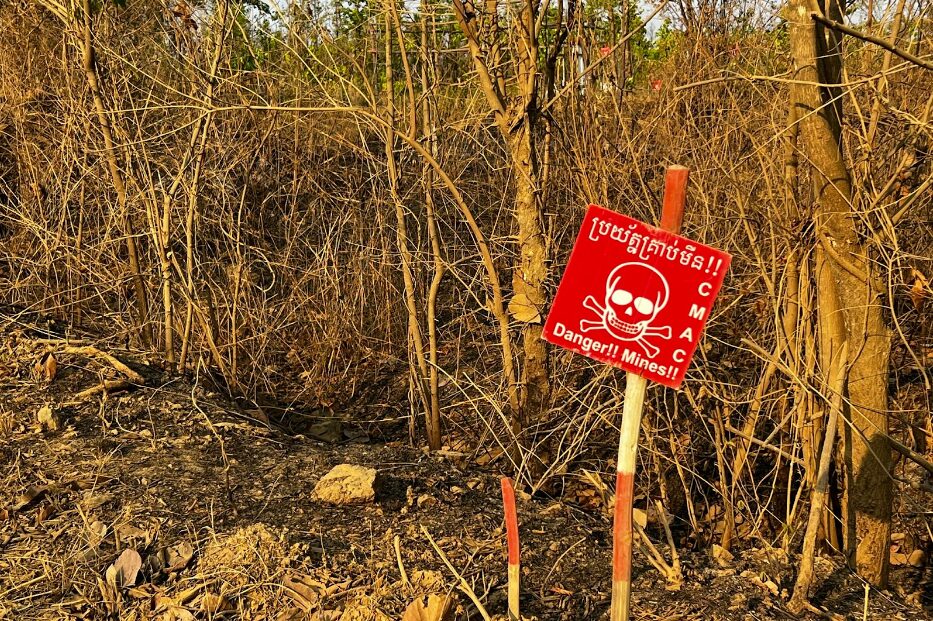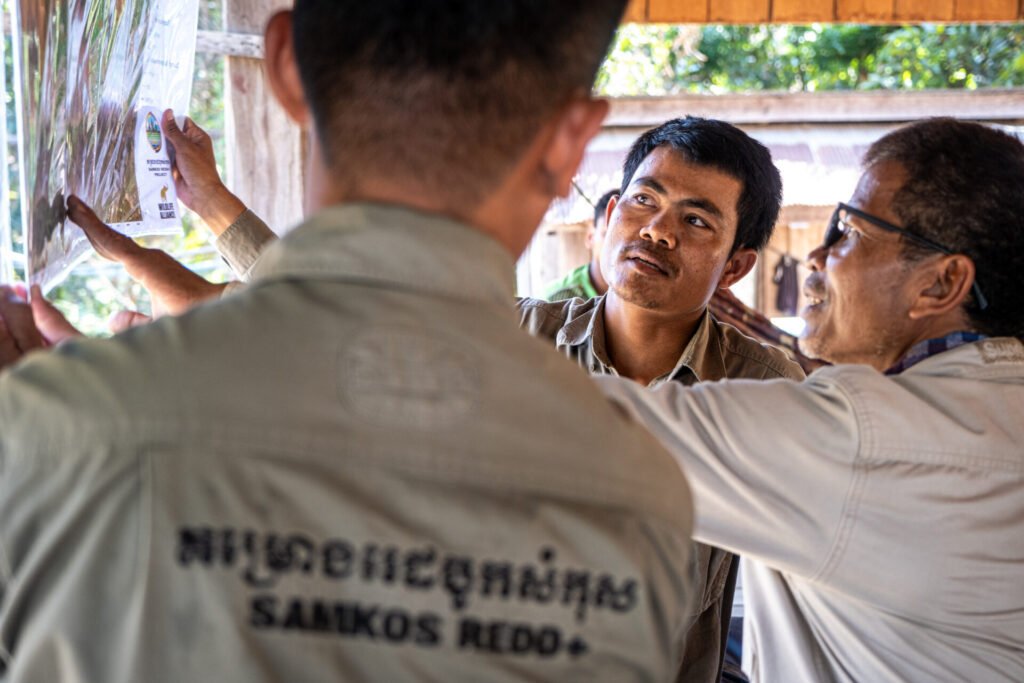
Nothing about Cambodia is straight forward. Every element of this magnificent country – its history, its culture, its people, its landscape, even its forests and wildlife – is complex, brutal and challenging, but also peaceful, bountiful and deeply intoxicating.
Nowhere is this more true, perhaps, than the Samlout District, a post-war minefield, where dispossessed communities are working hand in hand with Wildlife Alliance and Wildlife Works to protect a forest under siege.
Situated along the northern boundary of the Samkos REDD+ Project, Samlout is home to some of Cambodia’s poorest people, who are risking life and limb to raise crops in fields still scattered with landmines.
Chhoeum Ham, a farmer from the village of Veal Rolueum says: “People just take the risk of landmines to farm. Some villagers have tried disarming them… using a shovel, spoon and fork… but we don’t know how to disarm them safely.” Ham knows there are mines in his plantation. He has shown his children where they are and has to trust they will stay away, while any chance of improving his livelihood by introducing livestock is out of the question.
Many of the mines date back to the late 1970s, when Samlout became the last stronghold of the Khmer Rouge (KR), Pol Pot’s brutal regime, which killed millions of Cambodians through mass murder, forced labor and starvation during the Cambodian Genocide between 1975 and 1979. Both the KR and the overthrowing Kampuchean government used mines to weaponize the surrounding land. Ham, a former KR soldier, was himself responsible for laying mines in the dying days of the conflict, a war that cost him his left leg.
After several years in a refugee camp in Thailand, where the Khmer Rouge set up a government in exile, the Kampuchean government allowed former KR refugees like Ham to return, granting them the right to settle in Samlout. “Life was really hard after the refugee camps,” he says. “We worried every step we took and whenever we tried to build houses or do anything on the land.”
“There are still lots of mines in 12 villages in this area,” Ham says. There have been efforts to demine the area since the war, but the work is far from complete. “An NGO cleared some of the villages,” Ham explains, “But they wouldn’t operate within 10 kilometers of the Thai border, so they couldn’t help our village. We haven’t seen any mine clearance for the last 10 years.” Ham tells of five other people from his village who have lost limbs or died from landmines.
“This is why the Samkos REDD+ Project is so important to us,” he says.
Wildlife Alliance’s work with communities – efforts that are dependent on funding from the sale of carbon credits – has identified demining agricultural land as a top priority for the project to undertake to protect local communities and Indigenous peoples. This is also key to building new livelihood opportunities that enable prosperity while safeguarding the surrounding forests and wildlife.
These villages sit within the Phnom Samkos Wildlife Sanctuary (PSWS), which is dominated by three mountains: Phnom Samkos, Cambodia’s second highest peak at 1,717 meters, Phnom Khmaoch (1,496 m), and Phnom Tumpor (1,250 m). The area is also notable for its diverse forest types and rich biodiversity, including rare and unique species and is designated as an Important Bird Area (IBA).
Samlout is also home to several communities of Por Indigenous people, who are among the most marginalized groups in Cambodia and have been displaced by the Khmer Rouge. Their culture and spirituality is deeply intertwined with the landscape and the forest, but faces a growing existential threat.
Deforestation on traditional lands is a point of particular concern to the Por, who fear for the loss of their traditional nature spirits, the inability to carry out ceremonial rites and loss of their spiritual and cultural land. Working in partnership with the Por people to strengthen, document and promote their cultural heritage and traditions is another key initiative the Samkos project is prioritizing in Samlout, where the Por have long acted as guardians of cardamom fields and protectors of key tree species including agarwood and resin trees that today sit within the PSWS.
But protecting this critical landscape is a dangerous and complex business. The prevalence of landmines presents a huge risk to community members and forest protection personnel alike, and it also exacerbates some of the key drivers of deforestation. Under the Khmer Rouge, private land ownership was abolished and cadastral records were destroyed leaving an entire nation dispossessed. In this part of Cambodia, establishing and demarcating land rights, which is one of the lengthy and painstakingly complex steps in rebuilding the country’s economic, social and cultural foundations, is a literal and metaphorical minefield.
In their search for arable land, and without clear land rights, villagers have been clearing trees in the forest to expand agricultural land. “Land measurement has happened in Veal Rolueum,” Ham says “but only on the areas of flat land. The government team didn’t agree to measure on the mountain because of the landmines.”
Wildlife Alliance, with the help of Wildlife Works, has been working in close collaboration with communities, Indigenous members, local authorities, forest rangers and the Ministry of Environment to support efforts to strengthen land rights in Samlout by conducting Participatory Village Sketch Mapping and rigorous ground truthing by foot and drone. This process, which is a precondition for wider community development and conservation efforts, combines villagers’ local knowledge with detailed satellite and aerial imagery on land and resource use to empower community members while protecting the integrity of the forest.

What is most striking about this challenging and deeply moving encounter with Ham, and many other community members, though is the incredible reconciliation and forgiveness of the people living in this area, where former KR and government soldiers live shoulder to shoulder with Indigenous communities, all trying to secure a better future for their families.
It throws into strong light the context of Cambodia’s history, of political upheaval, war, genocide, and the incredible challenge of rebuilding a nation dispossessed of property, where Indigenous culture was systematically destroyed, and the educated were eradicated or fled.
And within that context, the seemingly insurmountable task of halting ferocious deforestation.
But in this particular minefield of Samlout, this beautiful, war-torn tangle of survival, reconciliation and abundant biodiversity, some of the most courageous and generous people on the planet are working to build a future where communities and the forest can thrive side by side.